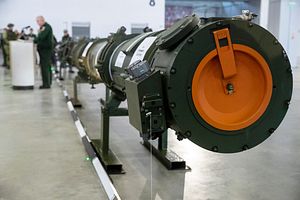On Wednesday, Russia invited journalists to a public briefing on the 9M729 cruise missile, the system that the United States has alleged is in violation of the 1987 Intermediate-Range Nuclear Forces (INF) Treaty. The briefing comes ahead of an anticipated withdrawal notification from the Treaty by the United States.
The briefing was designed to offer, for the first time, direct evidence of the missile’s features to push back against the U.S. accusation, which has held across the Obama and Trump administrations. Accordingly, the Russian Ministry of Defense made physically available at the briefing the transporter-erector-launcher for the 9M729 as well as the cruise missile’s launch canister.
The decanisterized missile itself was not available for viewing, but a slideshow at the briefing elaborated on the missile’s features, showing an enlarged warhead “with increased power” from the 9M728, treaty-compliant missile. The 9M729 also features a “modernized onboard correction system,” according to the Russian Ministry of Defense.
“The 9M729 missile carries combat equipment with the enhanced capacity and the new onboard control system, which provides for the higher accuracy of the missile’s strike,” Chief of the Russian Missile and Artillery Force Lieutenant-General Mikhail Matveyevsky said at the briefing.
“The warhead and the control system have been finalized and the missile’s length has been extended, which has increased its weight,” he added.
All together, the Ministry of Defense clarified the two core differences between the 9M728 and 9M729 as the former being 530 mm longer than the latter, with a range that is actually 10 km shorter.
The briefing did not directly rebut a 2018 statement by the U.S. Director of National Intelligence on the testing record of the missile. In early December, Dan Coats, the U.S. director of National Intelligence, noted that Russia had “initially flight tested the 9M729 – a ground based missile – to distances well over 500 kilometers (km) from a fixed launcher.
“Russia then tested the same missile at ranges below 500 km from a mobile launcher,” he’d added, elaborating on how the U.S. intelligence community had come to its assessment that the missile violated the treaty. “By putting the two types of tests together, Russia was able to develop a missile that flies to the intermediate ranges prohibited by the INF Treaty and launches from a ground-mobile platform.”
To address concerns over the missile’s testing history, the Russian Ministry of Defense revealed topline testing data within a specific location at the Kapustin Yar proving grounds. A slide shown at the briefing included total test figures across the Russian Missile Troops and Artillery, Aerospace Forces and Air Defense Forces, and Strategic Missile Troops between 2008 and 2014.
The 1987 INF Treaty barred the United States and the Soviet Union—and successively Russia, after the fall of the Soviet Union—from developing, testing, deploying, and possessing ground-launched cruise and ballistic missiles with ranges between 500 and 5,500 kilometers indefinitely.
While Russia and the United States have held consultations on the Treaty since the United States made clear its intent to withdraw amid Moscow’s alleged violation, there has been little progress. Washington is expected to deliver its withdrawal notification formally on February 2, beginning a six-month process that will see it leave the Treaty.

































